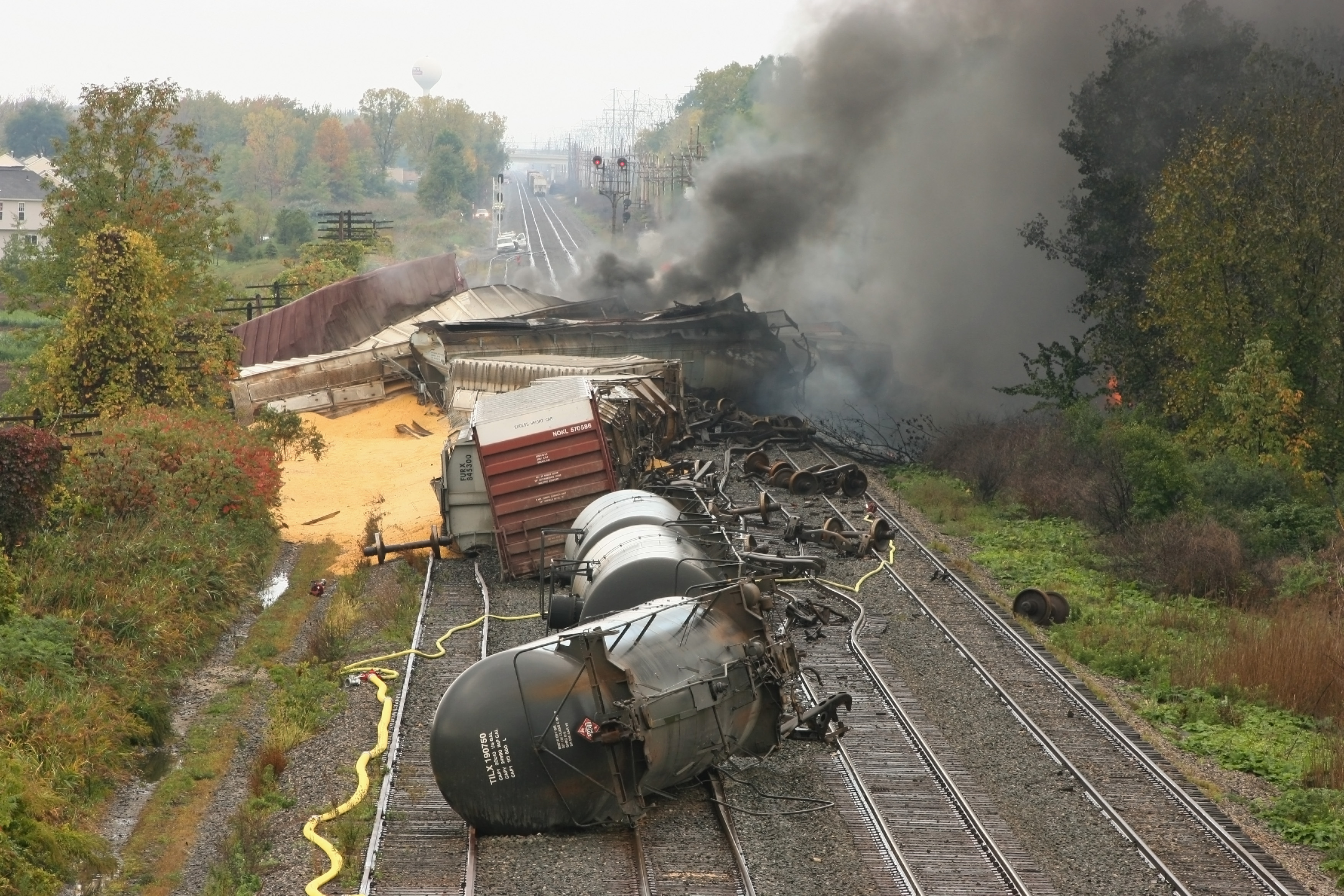
This post is brought to us by Jim Nortz, a thought leader in ethics and compliance and the titular corporate train wreck survivor. It’s difficult perhaps to recognize the “point of no return” when you’re on a runaway train, but (as they say) hindsight is 20/20. Today, Jim takes a looks back at his own unfortunate business experience. –Maurice Gilbert
 It all started peacefully enough. At 7 a.m., I parked my car in the underground parking garage of our Connecticut offices and hopped on the elevator. One floor later, the doors opened. In walked our senior vice president of HR alongside our brand new CEO, who happened to be arriving for his first day of work. There were introductions all around, and I welcomed our new chief to the company and wished him good luck in the challenges that lay ahead.
It all started peacefully enough. At 7 a.m., I parked my car in the underground parking garage of our Connecticut offices and hopped on the elevator. One floor later, the doors opened. In walked our senior vice president of HR alongside our brand new CEO, who happened to be arriving for his first day of work. There were introductions all around, and I welcomed our new chief to the company and wished him good luck in the challenges that lay ahead.
At the time this CEO arrived, our company was a 75-year-old global specialty chemical company with about $4 billion in annual revenue. We were cash-flush and profitable, but we also were facing multiple challenges, including but not limited to price squeezes on commodity products, legacy Superfund and toxic tort liabilities, multiple ERPs across our global operations, high employee injury rates and manufacturing facilities that had suffered from decades of neglect by prior management.
Itching to make a difference and seeing many opportunities for improvement, the new CEO launched the company into what was called the “60-Day War” — a collaboration between the corporate business heads and functional groups to formulate a grand plan to set the company on a long-term path to higher growth and profitability.
Once the plan was completed, we all worked over the next two years to implement it. Nearly a billion dollars was spent closing some plants, expanding capacity in others and improving safety, health and environmental performance overall. The projected return on investment for these expenditures was phenomenal, and we enthusiastically welcomed the chance to build a great company. Early on, Wall Street shared our excitement. Our stock price more than doubled in the first 12 months. Those of us who moved our 401(k) money into company stock felt like geniuses. However, as time progressed, many of us began to see some serious problems.
For reasons unknown to those of us outside of the C-suite, a decision was made to sole-source all engineering and construction for the project. Our engineering-to-capital-cost ratio soared, and we began to see tens of millions of dollars being wasted around the world. New reactors were installed incorrectly and had to be re-mounted, resulting in great expense and delays in operations. Services were provided that were not requested by plant operations. Bills were sent and paid for dozens of contract employees who hung out in trailers on site all day doing nothing, claiming to be waiting until projects commenced.
In one instance, the contractor failed to properly dry thousands of feet of new stainless steel pipelines after a pressure test, causing irreparable damage to the pipes, all of which had to be torn out and replaced at a cost of tens of millions of dollars. And, inexplicably, we paid all of these bills without dispute.
After a time, my immediate peers and I could see that we were on the wrong track and that it was just a matter of time before the whole thing derailed with all of us on board. Time and again in our meetings, we shared an astonished disbelief that those driving the train — whom we all knew and worked with — continued to stoke the fire and press on ever faster toward certain doom.
Two years into our corporate turnaround, the inevitable happened. The numbers made it impossible for management to convince the Board that the future was bright. The stock price plunged from a high in the mid forties to the teens. Our senior vice president of operations was forced to resign for gross project mismanagement. And there were unconfirmed rumblings that the Board was going to send the CEO his walking papers as well.
Seeing the writing on the wall, our CEO managed to talk the Board into approving a “merger of equals” with a smaller company. Once this transaction was completed, he and the senior management team jumped out of the runaway train and floated safely to the ground with multimillion-dollar golden parachutes. The rest of us who were left on the train plunged off the tracks into a very deep ravine. Several years later, despite the efforts of subsequent management teams to stop the inevitable, the train hit bottom and the company declared bankruptcy.
Fortunately for my family and me, while the train was still in mid-air, I was offered a tin parachute and was able to escape before the crash. The same can’t be said for many of my colleagues who rode it to the bottom.
Sadly, this tale is not unique. Millions of employees around the world have suffered the consequences of gross mistakes made by senior management teams who take spectacular risks because they have the kind of “heads I win, tails I win” deal we would all like to have. I share these reflections about my experience not to pillory corporate leaders who engage in reckless business practices but to ask the following question: What, if anything, could I have done to change the outcome?
There were a significant number of fairly high-ranking professionals like me in the company who saw what was happening and took no action to try to slow it down or to change course. By the time the danger became apparent, it might have been too late to put on the brakes or change tracks. There are a lot of other reasons to justify our collective inaction, such as our relative lack of authority and the difficulty of backing up our suspicions with solid evidence. These challenges were compounded by the fact that the senior vice president of operations in charge of the project was an intimidating, arrogant, prideful man who would have been extremely difficult to persuade, let alone take on head-to-head by appealing directly to the CEO or the Board. Nevertheless, I regret now not trying to lead an effort to organize my colleagues early on to gather and present our collective concerns to the company’s management team and the Board. Had we done so, I believe we might have found some allies on the senior management team who were like-minded and looking for a way to change course.
I don’t think it would be reasonable to assert that anyone in a similar situation is ethically compelled to risk their career and reputation by trying to prevent a corporate train wreck, especially in circumstances when such a sacrifice would likely be futile. I do think, however, that those of us in responsible positions owe it to ourselves, and everyone else on the train, to at least consider “pulling the brake cord” when we see trouble ahead on the tracks.
This article appeared previously in Association of Corporate Counsel’s ACC Docket and is published here with permission from the journal.
 Jim Nortz is a nationally recognized expert and thought leader in the field of business ethics and compliance. Jim spent the first 17 years of his career as a litigator trying both criminal and civil cases before becoming Crompton Corporation’s first Vice President, Business Ethics and Compliance in 2003. Since then, Jim has served as a compliance officer at Crompton and for three other multinational corporations – the latest of which was Bausch & Lomb.
Jim Nortz is a nationally recognized expert and thought leader in the field of business ethics and compliance. Jim spent the first 17 years of his career as a litigator trying both criminal and civil cases before becoming Crompton Corporation’s first Vice President, Business Ethics and Compliance in 2003. Since then, Jim has served as a compliance officer at Crompton and for three other multinational corporations – the latest of which was Bausch & Lomb.
Mr. Nortz is a frequent guest lecturer at the University of Rochester’s Simon School of Business, RIT’s Saunders School of Business, St. John Fisher College and Nazareth College. Jim writes the monthly business ethics columns for the Association of Corporate Counsel Docket magazine and the Rochester Business Journal and is a contributing writer for Corporate Compliance Insights and The Business Journals.
Jim served on the Board of Directors for the Ethics and Compliance Officers Association (“ECOA”) for eight years and is now on the Board of the Rochester Area Business Ethics Foundation. Jim is currently a compliance & ethics consultant and educator with Built on Ethics Advisory Services – a firm dedicated to helping organizations thrive by building sound internal controls and a strong ethical culture.
Published by Conselium Executive Search, the global leader in compliance search.

